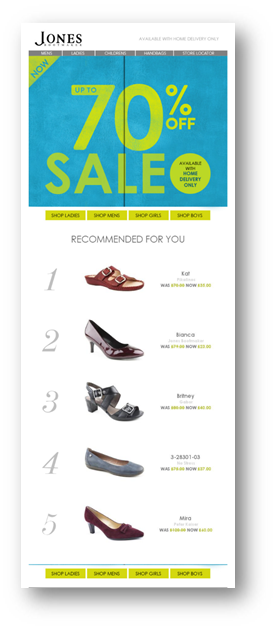In a recent Success in the inbox study Email on Acid found 68% of email marketers considered personalisation as a priority for improving the effectiveness of their campaigns. Yet how many personalised emails from brands have you received recently?
Personalisation has shown to be notoriously difficult to implement for many email marketers.
Multi-channel footwear retailer Jones Bootmaker went through this exact challenge of moving from one-size fits all messaging to 1:1 personalised messages. Using the Reignite email personalisation platform they added personalised product recommendations across a range of CRM campaigns.
This article shows you some of the learnings they made along the way.
What to do with all your customer data?
Jones Bootmaker had invested heavily in an in-store data capture programme which dramatically improved their email collection rate from around 5% of all in-store transactions to nearly 20%.
An email address on its own has some value, but they were also able to link this to the purchase, enabling them to see what the customer had purchased.
Having the data was one thing, the next action was what to do with it.
Clearly with several thousand products available across genders, brands and styles the most value could be gained by personalising products in emails based upon the individual’s taste.
The solution was to use artificial intelligence to generate personalised recommendations of what that customer would most likely want to buy next. The underlying algorithm for this is similar to what you might see on Amazon of ‘people who bought this also bought this’.
Yet that model needed the marketing team expert human input to tune it properly.
Fine-tuning Product Recommendations
Most recommendation engines would end up showing the customer similar items – perfect if you are trying to convert a shopper on a website based upon their current browsing history. But if you had just bought a pair of black work shoes the last thing you want to see is more black work shoes.
The role of email here is to inspire the next purchase, so categories of recent past purchases were excluded from recommendations.
But then another unforeseen issue was found. The recommendations appeared relevant for each customer’s taste profile, but it was a wall of black and brown shoes – there was nothing inspirational. This was simply because most customers have fairly safe tastes, and the bulk of stock is held in these colours. If you looked in the shop window of their store you would see all the colours of the rainbow. In fact, the buying team would buy limited amounts of more colourful shoes simply for the purposes of window displays knowing this is what draws the customer in, but they’ll always buy that shoe in the black or brown version instead!
This was fed into the recommendations to upweight the more colourful products, while still ensuring products remained in taste in relation to brands and styles.
This is a great example of how leaving the computer to make all decisions without your own expert input can lead to suboptimal results. That is also great news for marketers too as your role isn’t about to be made redundant for a robot!
Here is how Jones Bootmaker then used these recommendations in live campaigns.
Next Purchase Campaign
The next priority was to start converting the in-store shoppers to shopping online and a triggered campaign was created for this purpose at 30 days post in-store signup.
This was split into 2 gender segments, with a personalised hero image of the customer’s name appearing as the shoe label for added impact, and to align with the ‘Exclusive offer for you’ messaging.
The recommendations were then displayed underneath this to inspire that next purchase.
An incremental 1 in 60 customers bought online because of this email.

Sale Campaigns
Jones Bootmaker like many brands in their space rely on sale promotions that can run for several weeks at a time. Keeping email messaging fresh during the promotion always proved a challenge as there was always a reluctance to include products in the emails. Most sale stock was fragmented with only a few sizes left so if a customer clicked through there was a high probability their size wouldn’t be available.
However, by using the recommendations they were able to filter any products shown in the email to those still available in the customer’s size.
The result was far more engaging emails over this time and dramatically increased conversion rates. Revenue from sale emails using recommendations increased by 62%.

Cart & Browse Recovery
To improve online conversion Jones Bootmaker ran both Browse & Cart Recovery email programmes.
In the browse emails instead of inspiration, conversion was the main purpose. Therefore, the emails were targeted based upon the customer intent in their last visit by using recommendations of very similar styles. Rather than present these as a big brother ‘we see you were looking at our site’ this was turned into a brand or style led campaign such as ‘Most Wanted Jones Bootmaker’ or ‘Most Wanted Sandals’.
With everything measured using hold-out cells to calculate the incremental uplift, these browse emails contributed to over 2% off all online revenue.

Takeaways
I hope these examples help understand some of the detail you need to think through when planning and implementing email personalisation. Here are the main points I think are the key takeaways:
- Focus on maximising the amount of data you can capture on customers interests and tastes.
- Don’t expect machines to do all the thinking – adding your expert input to make the personalisation work in the real world is key
- Use a variety of personalisation approaches to fit different campaign objectives
Read on for more good advice in the fashion email marketing guide. You’ll find more fashion examples and tips from welcome to win-back.
